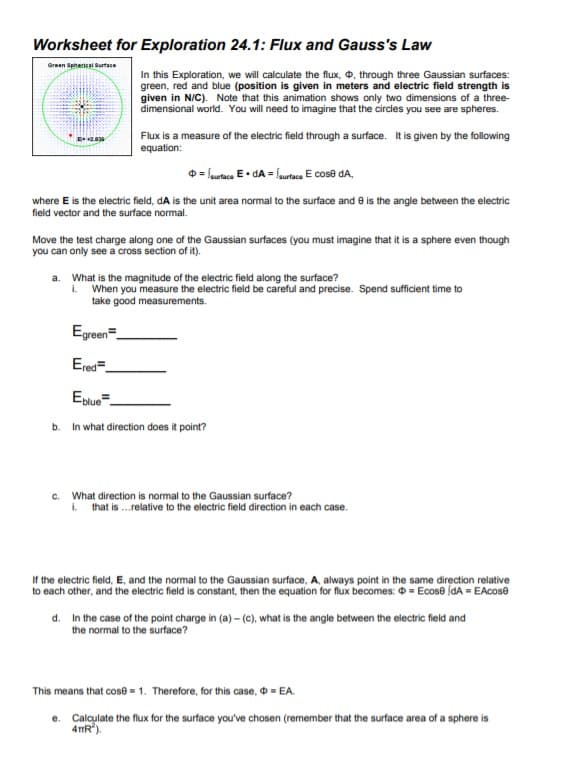Worksheet for Exploration 24.1: Flux and Gauss's Law Green Sphensal Surtace In this Exploration, we will calculate the flux, 0, through three Gaussian surfaces: green, red and blue (position is given in meters and electric field strength is given in N/C). Note that this animation shows only two dimensions of a three- dimensional world. You will need to imagine that the circles you see are spheres. Flux is a measure of the electric field through a surface. It is given by the following equation: O= lautace E• dA = furtaes E cose dA, where E is the electric field, dA is the unit area normal to the surface and e is the angle between the electric field vector and the surface normal. Move the test charge along one of the Gaussian surfaces (you must imagine that it is a sphere even though you can only see a cross section of it). a. What is the magnitude of the electric field along the surface? i. When you measure the electric field be careful and precise. Spend sufficient time to take good measurements. Egreen= Ered= Eplue= b. In what direction does it point? c. What direction is normal to the Gaussian surface? i. that is .relative to the electric field direction in each case. If the electric field, E, and the normal to the Gaussian surface, A, always point in the same direction relative to each other, and the electric field is constant, then the equation for flux becomes: = Ecose (dA = EAcose d. In the case of the point charge in (a) – (c), what is the angle between the electric field and the normal to the surface? This means that cose = 1. Therefore, for this case, o = EA. e. Caloulate the flux for the surface you've chosen (remember that the surface area of a sphere is 4 mR).
Worksheet for Exploration 24.1: Flux and Gauss's Law Green Sphensal Surtace In this Exploration, we will calculate the flux, 0, through three Gaussian surfaces: green, red and blue (position is given in meters and electric field strength is given in N/C). Note that this animation shows only two dimensions of a three- dimensional world. You will need to imagine that the circles you see are spheres. Flux is a measure of the electric field through a surface. It is given by the following equation: O= lautace E• dA = furtaes E cose dA, where E is the electric field, dA is the unit area normal to the surface and e is the angle between the electric field vector and the surface normal. Move the test charge along one of the Gaussian surfaces (you must imagine that it is a sphere even though you can only see a cross section of it). a. What is the magnitude of the electric field along the surface? i. When you measure the electric field be careful and precise. Spend sufficient time to take good measurements. Egreen= Ered= Eplue= b. In what direction does it point? c. What direction is normal to the Gaussian surface? i. that is .relative to the electric field direction in each case. If the electric field, E, and the normal to the Gaussian surface, A, always point in the same direction relative to each other, and the electric field is constant, then the equation for flux becomes: = Ecose (dA = EAcose d. In the case of the point charge in (a) – (c), what is the angle between the electric field and the normal to the surface? This means that cose = 1. Therefore, for this case, o = EA. e. Caloulate the flux for the surface you've chosen (remember that the surface area of a sphere is 4 mR).
Related questions
Question

Transcribed Image Text:Worksheet for Exploration 24.1: Flux and Gauss's Law
Green Sphensal Surtace
In this Exploration, we will calculate the flux, 0, through three Gaussian surfaces:
green, red and blue (position is given in meters and electric field strength is
given in N/C). Note that this animation shows only two dimensions of a three-
dimensional world. You will need to imagine that the circles you see are spheres.
Flux is a measure of the electric field through a surface. It is given by the following
equation:
O= lautace E• dA = furtaes E cose dA,
where E is the electric field, dA is the unit area normal to the surface and e is the angle between the electric
field vector and the surface normal.
Move the test charge along one of the Gaussian surfaces (you must imagine that it is a sphere even though
you can only see a cross section of it).
a. What is the magnitude of the electric field along the surface?
i. When you measure the electric field be careful and precise. Spend sufficient time to
take good measurements.
Egreen=
Ered=
Eplue=
b. In what direction does it point?
c. What direction is normal to the Gaussian surface?
i. that is .relative to the electric field direction in each case.
If the electric field, E, and the normal to the Gaussian surface, A, always point in the same direction relative
to each other, and the electric field is constant, then the equation for flux becomes: = Ecose (dA = EAcose
d. In the case of the point charge in (a) – (c), what is the angle between the electric field and
the normal to the surface?
This means that cose = 1. Therefore, for this case, o = EA.
e. Caloulate the flux for the surface you've chosen (remember that the surface area of a sphere is
4 mR).
Expert Solution
This question has been solved!
Explore an expertly crafted, step-by-step solution for a thorough understanding of key concepts.
This is a popular solution!
Trending now
This is a popular solution!
Step by step
Solved in 2 steps
